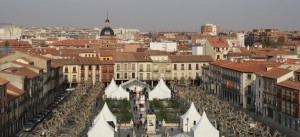Study in Alcala de Henares, Spain
Study in Alcala de Henares, Spain

Alcalá de Henares, meaning Citadel on the River Henares, is a grand Spanish city whose historical center is one of UNESCO's World Heritage Sites. The city stands out for its rich archaeology and was one of the first bishoprics founded in Spain. Located in the Autonomous Community of Madrid, some 22 miles (35kms) northeast of the city of Madrid, at an altitude of 588 m (1,929 ft) above sea level, the city has a population of around 200,000 permanent inhabitants. Locally, the city is generally known simply as "Alcalá," but "de Henares" is added when needed to differentiate it from a dozen other Spanish cities sharing the name Alcalá, meaning “Citadel.”. The Latin name of the city, Complutum, is sometimes used in official circles. The city of Alcala de Henares is also the capital of its namesake region, the Comarca de Alcalá.
Alcala de Henares is the birthplace of well-known novelist Miguel de Cervantes, author of “Don Quixote,” perhaps the most important piece of Spanish fiction. The city is also home to one of the most prestigious universities in all of Spain, known locally as the Colegio Mayor de San Ildefonso. The city’s rich monumental heritage, formed by churches, convents and university buildings, gives us a glimpse of life in Old Castilia during the Spanish Golden Age. Its historic quarter also has the “Hostería del Estudiante” Inn, which is part of the network of Paradores de Turismo. Walls, with four hundred years of history, make Alcala de Henares the perfect place for discovering the history of the Autonomous Community of Madrid.
Things to Do and See in Alcala de Henares
Today there are hundreds of things to do in Alcala and its designation as a UNESCO World Heritage site is a good indication that the tourism in this fine city absolutely thrives. Walking tours are perhaps one of the top things to do in Alcala and are almost certainly the best way to explore the historic city core and all it has to offer. Narrow, winding streets, built of cobbled stone, wander through the oldest city areas, giving visitors a rare taste of what the city might have been like a century or more ago.
The University
Alcalá de Henares owes its UNESCO World Heritage status to the fact that it was a university city before other towns thought to create such centers. Indeed, Alcalá de Henares was one of the very first towns to be constructed with a university in mind, and other European cities later looked to Alcalá for inspiration when constructing their own colleges. Because the historic center was built specifically to provide a first-class education, many of the impressive buildings encountered in Alcalá de Henares belong to the university, located very near the city center.
The Main Square
The university fans out from the main square, known locally as Plaza de Cervantes, dedicated to the memory of the novelist of the same name. Many bars and restaurants have terraces located here in the plaza, making it a comfortable place for relaxing and refueling while enjoying the unmistakable ambience. This pleasant square is the scene of ever-changing events; it hosts an ice rink in winter and an open-air theater in the spring. It is especially beautiful in May and June, when the roses are in bloom. If you happen to visit in October, don’t miss the Medieval Fair, which fills the square and the surrounding area with barbecued foods, costumed actors, and a multitude of colorful street vendors.
Miguel de Cervantes’ House
A short stroll from the main square, the childhood home of Miguel de Cervantes can be visited free of charge. Step inside and imagine what it was like to live in this two-story building during the 1500s. The walls are hung with a few paintings and religious icons, just as they might have been during the time when Cervantes was a boy. Exhibits on the second floor entertain what daily life was like in a comfortable residence such as this one in the 16th century. Outside the house is a bench where you can snap a picture with playful statues of Don Quixote and Sancho Panza, Cervantes’ most beloved characters.

